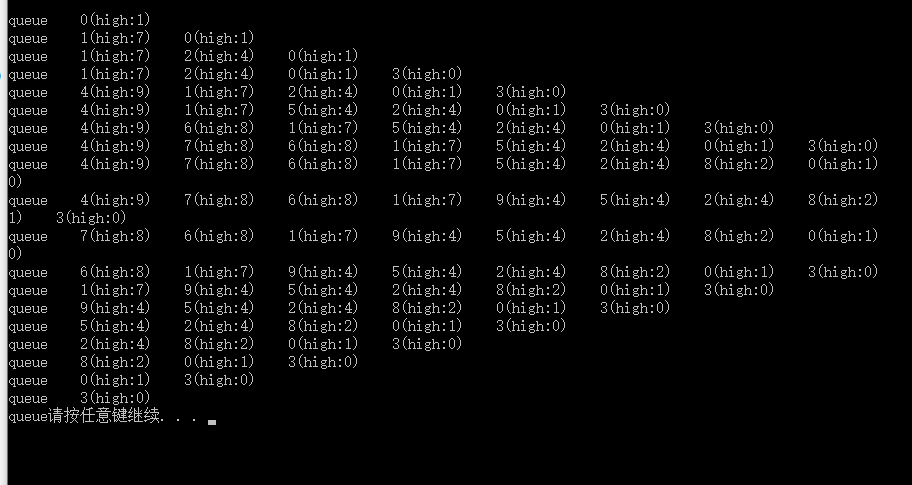- 运行截图:

- 节点的结构体定义
typedef struct queue { datatype data; int high;//优先级 struct queue *pNext; }Queue, *PQueue;
- //入队 入队的时候考虑优先级,优先级大的在前面
PQueue enq(PQueue phead, datatype data,int high) { PQueue pnew = (PQueue)malloc(sizeof(Queue)); pnew->data = data; pnew->high = high; pnew->pNext = NULL; if (phead == NULL) { phead = pnew;//直接插入 } else { //先判断头结点的优先级 if (phead->high <= high) { pnew->pNext = phead; phead = pnew; } else { //从头结点开始一直循环到后一个节点的优先级小于high的 PQueue ptemp = phead; //可能找到,也可能循环到尾部了还没找到,所以直接插在ptemp后面 while (ptemp->pNext != NULL) { if (ptemp->pNext->high <= high) { break; } ptemp = ptemp->pNext; } pnew->pNext = ptemp->pNext; ptemp->pNext = pnew; } } return phead; }
- 出队
1 PQueue deq(PQueue phead, datatype *pdata) 2 { 3 if (phead == NULL) 4 { 5 return NULL; 6 } 7 else 8 { 9 *pdata = phead->data;//获取弹出的数据 10 PQueue ptemp = phead->pNext; 11 free(phead); 12 phead = ptemp; 13 } 14 }
- 显示
1 void show(PQueue phead) 2 { 3 if (phead == NULL) 4 { 5 return; 6 } 7 else 8 { 9 printf("%5d(high:%d)", phead->data,phead->high); 10 show(phead->pNext);//递归调用 11 } 12 }
完整代码:
1 #include <stdio.h> 2 #include <stdlib.h> 3 4 #define datatype int 5 6 typedef struct queue 7 { 8 datatype data; 9 int high;//优先级 10 struct queue *pNext; 11 }Queue, *PQueue; 12 13 //入队 从尾部出,从头部出 14 PQueue enq(PQueue phead, datatype data,int high) 15 { 16 PQueue pnew = (PQueue)malloc(sizeof(Queue)); 17 pnew->data = data; 18 pnew->high = high; 19 pnew->pNext = NULL; 20 if (phead == NULL) 21 { 22 phead = pnew;//直接插入 23 } 24 else 25 { 26 //先判断头结点的优先级 27 if (phead->high <= high) 28 { 29 pnew->pNext = phead; 30 phead = pnew; 31 } 32 else 33 { 34 //从头结点开始一直循环到后一个节点的优先级小于high的 35 PQueue ptemp = phead; 36 //可能找到,也可能循环到尾部了还没找到,所以直接插在ptemp后面 37 while (ptemp->pNext != NULL) 38 { 39 if (ptemp->pNext->high <= high) 40 { 41 break; 42 } 43 ptemp = ptemp->pNext; 44 } 45 pnew->pNext = ptemp->pNext; 46 ptemp->pNext = pnew; 47 } 48 } 49 return phead; 50 } 51 52 //出队 53 PQueue deq(PQueue phead, datatype *pdata) 54 { 55 if (phead == NULL) 56 { 57 return NULL; 58 } 59 else 60 { 61 *pdata = phead->data;//获取弹出的数据 62 PQueue ptemp = phead->pNext; 63 free(phead); 64 phead = ptemp; 65 } 66 } 67 68 //显示 69 void show(PQueue phead) 70 { 71 if (phead == NULL) 72 { 73 return; 74 } 75 else 76 { 77 printf("%5d(high:%d)", phead->data,phead->high); 78 show(phead->pNext);//递归调用 79 } 80 } 81 82 void main() 83 { 84 Queue *phead = NULL; 85 for (int i = 0; i < 10; i++) 86 { 87 phead = enq(phead, i,rand()%10); 88 printf(" queue"); 89 show(phead); 90 } 91 92 93 while (phead != NULL) 94 { 95 datatype data; 96 phead = deq(phead, &data); 97 //printf(" dequeue%d", data); 98 printf(" queue"); 99 show(phead); 100 } 101 102 system("pause"); 103 104 105 system("pause"); 106 }